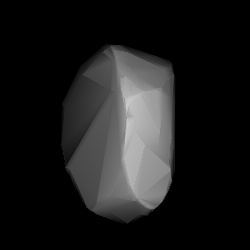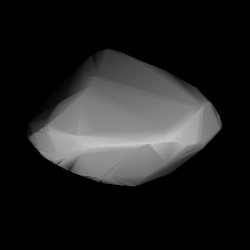Related Research Articles
4349 Tibúrcio, provisional designation 1989 LX, is a dark asteroid from the central region of the asteroid belt, approximately 29 kilometers in diameter. It was discovered on 5 June 1989, by German astronomer Werner Landgraf at ESO's La Silla Observatory in northern Chile.
606 Brangäne, provisional designation 1906 VB, is an asteroid from the central regions of the asteroid belt, approximately 36 kilometers in diameter. It was discovered on 18 September 1906, by astronomer August Kopff at the Heidelberg Observatory in southwest Germany. The unusual K-type asteroid is the namesake of the small Brangäne family and has a rotation period of 12.3 hours. It was named after Brangaine, a character from the opera Tristan und Isolde by Richard Wagner.
1024 Hale, provisional designation A923 YO13, is a carbonaceous background asteroid from the outer regions of the asteroid belt, approximately 45 kilometers (28 miles) in diameter. The asteroid was discovered on 2 December 1923, by Belgian–American astronomer George Van Biesbroeck at the Yerkes Observatory in Wisconsin, United States. It was named for American astronomer George Ellery Hale. The dark C-type asteroid may have a rotation period of 16 hours.
1178 Irmela, provisional designation 1931 EC, is a stony asteroid from the middle regions of the asteroid belt, approximately 19 kilometers in diameter.

1118 Hanskya is a large background asteroid, approximately 77 kilometers in diameter, located in the outer regions of the asteroid belt. Discovered by Sergey Belyavsky and Nikolaj Ivanov in 1927, it was named after Russian astronomer Aleksey Hansky. The presumed dark C-type asteroid has a rotation period of 15.6 hours.

1129 Neujmina is an Eos asteroid from the outer regions of the asteroid belt. It was discovered on 8 August 1929, by astronomer Praskoviya Parchomenko at the Simeiz Observatory on the Crimean peninsula. The stony S-type asteroid has a rotation period of 5.1 hours and measures approximately 34 kilometers in diameter. It was named after Soviet astronomer Grigory Neujmin.

1555 Dejan, provisional designation 1941 SA, is an asteroid from the background population of the central regions of the asteroid belt, approximately 22 kilometers in diameter. It was discovered on 15 September 1941, by Belgian astronomer Fernand Rigaux at the Royal Observatory of Belgium in Uccle. The asteroid was named after Dejan Đurković, son of Serbian astronomer Petar Đurković.
4282 Endate, provisional designation 1987 UQ1, is an asteroid from the inner regions of the asteroid belt, approximately 10 kilometers in diameter. It was discovered on 28 October 1987, by Japanese astronomers Seiji Ueda and Hiroshi Kaneda at Kushiro Observatory (399) in Japan. It was named for amateur astronomer Kin Endate.
9298 Geake, provisional designation 1985 JM, is a Mitidika asteroid from the central regions of the asteroid belt, approximately 12 kilometers in diameter. It was discovered on 15 May 1985, by American astronomer Edward Bowell at Lowell Observatory's Anderson Mesa Station near Flagstaff, Arizona, United States. The asteroid was named for British astronomer John E. Geake.
1267 Geertruida, provisional designation 1930 HD, is a carbonaceous background asteroid from the inner regions of the asteroid belt, approximately 20 kilometers in diameter. Discovered by astronomer Hendrik van Gent at Johannesburg Observatory in 1930, the asteroid was later named after Geertruid Pels, sister of Dutch astronomer Gerrit Pels.
4944 Kozlovskij, provisional designation 1987 RP3, is a carbonaceous Witt asteroid from the central regions of the asteroid belt, approximately 10 kilometers (6 miles) in diameter. It was discovered on 2 September 1987, by Soviet astronomer Lyudmila Chernykh at the Crimean Astrophysical Observatory in Nauchnij, on the Crimean Peninsula. The asteroid was named for Russian opera singer Ivan Kozlovsky.
1306 Scythia, provisional designation 1930 OB, is a dark Ursula asteroid from the outer regions of the asteroid belt, approximately 72 kilometers in diameter. It was discovered on 22 July 1930, by Soviet astronomer Grigory Neujmin at the Simeiz Observatory on the Crimean peninsula. The asteroid was named for the historic region of Scythia.
3133 Sendai, provisional designation A907 TC, is a stony Flora asteroid from the inner regions of the asteroid belt, approximately 8 kilometers in diameter. It was discovered on 4 October 1907, by German astronomer August Kopff at Heidelberg Observatory in southwest Germany. The asteroid was named for the Japanese city of Sendai.
2882 Tedesco, provisional designation 1981 OG, is a Themistian asteroid from the outer regions of the asteroid belt, approximately 22 kilometers in diameter. It was discovered on 26 July 1981, by astronomer Edward Bowell at the Anderson Mesa Station near Flagstaff, Arizona. The likely elongated C-type asteroid has a rotation period of 19.8 hours. It was named for American astronomer Ed Tedesco.
2443 Tomeileen, provisional designation A906 BJ, is a stony Eoan asteroid from the outer regions of the asteroid belt, approximately 32 kilometers in diameter. It was discovered on 24 January 1906, by German astronomer Max Wolf at the Heidelberg-Königstuhl State Observatory in Heidelberg, Germany. The S-type asteroid was named after the parents of British astronomer Brian G. Marsden. It has a rotation period of 3.97 hours.

2111 Tselina is a stony Eos asteroid from the outer regions of the asteroid belt. It was discovered on 13 June 1969, by Soviet astronomer Tamara Smirnova at Crimean Astrophysical Observatory in Nauchnij, on the Crimean peninsula. The S-type asteroid has a rotation period of 6.6 hours and measures approximately 23 kilometers in diameter. It was later named after the Soviet Virgin Lands Campaign.

1186 Turnera, provisional designation 1929 PL, is a stony Eoan asteroid from the outer regions of the asteroid belt, approximately 36 kilometers in diameter. It was discovered on 1 August 1929, by South African astronomer Cyril Jackson at the Union Observatory in Johannesburg. The asteroid was later named after British astronomer Herbert Hall Turner.
3823 Yorii, provisional designation 1988 EC1, is a carbonaceous asteroid from the outer region of the asteroid belt, approximately 11 kilometers in diameter.
1544 Vinterhansenia, provisional designation 1941 UK, is a dark asteroid from the inner regions of the asteroid belt, approximately 22 kilometers in diameter. It was discovered on 15 October 1941, by Finnish astronomer Liisi Oterma at Turku Observatory in Southwest Finland, and named for Danish astronomer Julie Vinter Hansen.
57868 Pupin, provisional designation 2001 YD, is a dark Erigonian asteroid and slow rotator from the inner regions of the asteroid belt, approximately 3.5 kilometers in diameter. It was discovered on December 17, 2001, by astronomers of Near-Earth Asteroid Tracking (NEAT) at the Palomar Observatory in California, United States. The asteroid was named after Serbian–American physicist Mihajlo Pupin.
References
- 1 2 3 4 5 6 7 8 "JPL Small-Body Database Browser: 589 Croatia (1906 TM)" (2017-07-05 last obs.). Jet Propulsion Laboratory . Retrieved 14 December 2017.
- ↑ Noah Webster (1884) A Practical Dictionary of the English Language
- 1 2 3 Schmadel, Lutz D. (2007). "(589) Croatia". Dictionary of Minor Planet Names. Springer Berlin Heidelberg. p. 61. doi:10.1007/978-3-540-29925-7_590. ISBN 978-3-540-00238-3.
- 1 2 3 4 5 6 7 "LCDB Data for (589) Croatia". Asteroid Lightcurve Database (LCDB). Retrieved 14 December 2017.
- 1 2 "Asteroid 589 Croatia – Nesvorny HCM Asteroid Families V3.0". Small Bodies Data Ferret. Retrieved 24 October 2019.
- 1 2 3 4 Nugent, C. R.; Mainzer, A.; Bauer, J.; Cutri, R. M.; Kramer, E. A.; Grav, T.; et al. (September 2016). "NEOWISE Reactivation Mission Year Two: Asteroid Diameters and Albedos". The Astronomical Journal. 152 (3): 12. arXiv: 1606.08923 . Bibcode:2016AJ....152...63N. doi: 10.3847/0004-6256/152/3/63 .
- 1 2 3 4 Tedesco, E. F.; Noah, P. V.; Noah, M.; Price, S. D. (October 2004). "IRAS Minor Planet Survey V6.0". NASA Planetary Data System. 12: IRAS-A-FPA-3-RDR-IMPS-V6.0. Bibcode:2004PDSS...12.....T . Retrieved 22 October 2019.
- 1 2 3 4 Usui, Fumihiko; Kuroda, Daisuke; Müller, Thomas G.; Hasegawa, Sunao; Ishiguro, Masateru; Ootsubo, Takafumi; et al. (October 2011). "Asteroid Catalog Using Akari: AKARI/IRC Mid-Infrared Asteroid Survey". Publications of the Astronomical Society of Japan. 63 (5): 1117–1138. Bibcode:2011PASJ...63.1117U. doi:10.1093/pasj/63.5.1117. (online, AcuA catalog p. 153)
- 1 2 3 4 Masiero, Joseph R.; Mainzer, A. K.; Grav, T.; Bauer, J. M.; Cutri, R. M.; Nugent, C.; et al. (November 2012). "Preliminary Analysis of WISE/NEOWISE 3-Band Cryogenic and Post-cryogenic Observations of Main Belt Asteroids". The Astrophysical Journal Letters. 759 (1): 5. arXiv: 1209.5794 . Bibcode:2012ApJ...759L...8M. doi:10.1088/2041-8205/759/1/L8 . Retrieved 14 December 2017.
- 1 2 3 4 5 6 Mainzer, A.; Grav, T.; Masiero, J.; Hand, E.; Bauer, J.; Tholen, D.; et al. (November 2011). "NEOWISE Studies of Spectrophotometrically Classified Asteroids: Preliminary Results". The Astrophysical Journal. 741 (2): 25. arXiv: 1109.6407 . Bibcode:2011ApJ...741...90M. doi:10.1088/0004-637X/741/2/90.
- 1 2 Warner, Brian D. (June 2008). "Asteroid Lightcurve Analysis at the Palmer Divide Observatory - June - October 2007". The Minor Planet Bulletin. 35 (2): 56–60. Bibcode:2008MPBu...35...56W. ISSN 1052-8091 . Retrieved 14 December 2017.
- 1 2 3 Waszczak, Adam; Chang, Chan-Kao; Ofek, Eran O.; Laher, Russ; Masci, Frank; Levitan, David; et al. (September 2015). "Asteroid Light Curves from the Palomar Transient Factory Survey: Rotation Periods and Phase Functions from Sparse Photometry". The Astronomical Journal. 150 (3): 35. arXiv: 1504.04041 . Bibcode:2015AJ....150...75W. doi:10.1088/0004-6256/150/3/75 . Retrieved 14 December 2017.
- 1 2 Behrend, Raoul. "Asteroids and comets rotation curves – (589) Croatia". Geneva Observatory. Retrieved 14 December 2017.
- 1 2 Masiero, Joseph R.; Grav, T.; Mainzer, A. K.; Nugent, C. R.; Bauer, J. M.; Stevenson, R.; et al. (August 2014). "Main-belt Asteroids with WISE/NEOWISE: Near-infrared Albedos". The Astrophysical Journal. 791 (2): 11. arXiv: 1406.6645 . Bibcode:2014ApJ...791..121M. doi:10.1088/0004-637X/791/2/121.
- ↑ Veres, Peter; Jedicke, Robert; Fitzsimmons, Alan; Denneau, Larry; Granvik, Mikael; Bolin, Bryce; et al. (November 2015). "Absolute magnitudes and slope parameters for 250,000 asteroids observed by Pan-STARRS PS1 - Preliminary results". Icarus. 261: 34–47. arXiv: 1506.00762 . Bibcode:2015Icar..261...34V. doi:10.1016/j.icarus.2015.08.007 . Retrieved 14 December 2017.
- 1 2 3 "589 Croatia (1906 TM)". Minor Planet Center. Retrieved 14 December 2017.
- 1 2 Kučera, Oton (1910). . Glasnik Hrvatskoga Prirodoslovnoga Društva (XXII - prva polovina).
- 1 2 Tadej, Ivan (1973). . Almanah Bošković 1974 (26): 77–80.
- 1 2 Nesvorný, D.; Broz, M.; Carruba, V. (December 2014). "Identification and Dynamical Properties of Asteroid Families". Asteroids IV. pp. 297–321. arXiv: 1502.01628 . Bibcode:2015aste.book..297N. doi:10.2458/azu_uapress_9780816532131-ch016. ISBN 9780816532131.